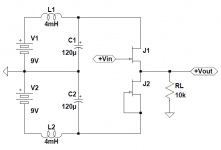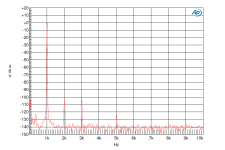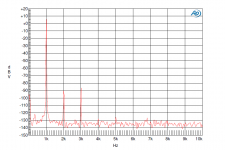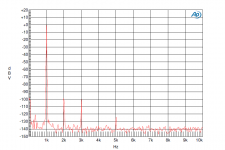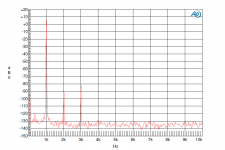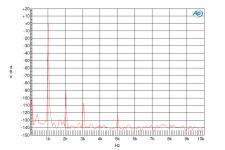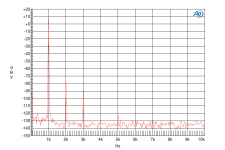In recent years, since Toshiba has stopped production of their low noise JFETs, there have been a lot of discussion about possible alternatives to replace them,
and what penalties there might be :
https://www.diyaudio.com/forums/pass-labs/142769-b1-jfet-alternatives-list.html
https://www.diyaudio.com/forums/pass-labs/317563-replacement-toshiba-2sk170-2sj74.html
The most recent discussion is probably the source follower used in the LX Mini Active Crossover.
Following the discussions there, we decided to put some substance behind that discussion.
https://www.diyaudio.com/forums/pass-labs/324747-lx-mini-crossover-article-6.html#post5501795
With the help of Jan Didden, we obtained access to an Audio Precision 2722 Distortion Analyser for half a day.
A small test setup was prepared to test various (Toshiba low noise) N-JFETs in a source follower buffer circuit.
The circuit consisted of 2x 9V alkaline batteries as power supply.
This was further filtered by 4mH Fastron inductors, followered by Panasonic FC 120μF capacitors.
Each of the N-JFET pairs used in the testing was matched to <10μA in Idss.
The output was loaded by a 10k ohm Vishay S102 bulk foil resistor.
The JFETs tested were
a. 2SK170BL at 8.2mA Idss
b. 2SK117BL at 7.5mA Idss
c. 2SK209GR at 3.8mA Idss
Single-ended input signal was 1Vrms and 2Vrms at 1kHz from the AP built-in waveform generator.
The results can be summarised.
DUT 1Vrms __H2 __H3__ 2Vrms H2 __H3
2SK170BL -102dB -104dB -96dB -92dB
2SK117BL -99dB -100dB -93dB -89dB
2SK209GR -92dB -107dB -86dB -97dB
As can be seen, there is very little performance difference between 2SK170 and 2SK117 (= 2SK209 in SMD) at the same Idss; on average about 3dB.
Halving the Idss push up the second harmonics by so 6dB, in return for 7dB lower third harmonics. The latter result (with the low H3) was rather unexpected and interesting.
Patrick
.
and what penalties there might be :
https://www.diyaudio.com/forums/pass-labs/142769-b1-jfet-alternatives-list.html
https://www.diyaudio.com/forums/pass-labs/317563-replacement-toshiba-2sk170-2sj74.html
The most recent discussion is probably the source follower used in the LX Mini Active Crossover.
Following the discussions there, we decided to put some substance behind that discussion.
https://www.diyaudio.com/forums/pass-labs/324747-lx-mini-crossover-article-6.html#post5501795
With the help of Jan Didden, we obtained access to an Audio Precision 2722 Distortion Analyser for half a day.
A small test setup was prepared to test various (Toshiba low noise) N-JFETs in a source follower buffer circuit.
The circuit consisted of 2x 9V alkaline batteries as power supply.
This was further filtered by 4mH Fastron inductors, followered by Panasonic FC 120μF capacitors.
Each of the N-JFET pairs used in the testing was matched to <10μA in Idss.
The output was loaded by a 10k ohm Vishay S102 bulk foil resistor.
The JFETs tested were
a. 2SK170BL at 8.2mA Idss
b. 2SK117BL at 7.5mA Idss
c. 2SK209GR at 3.8mA Idss
Single-ended input signal was 1Vrms and 2Vrms at 1kHz from the AP built-in waveform generator.
The results can be summarised.
DUT 1Vrms __H2 __H3__ 2Vrms H2 __H3
2SK170BL -102dB -104dB -96dB -92dB
2SK117BL -99dB -100dB -93dB -89dB
2SK209GR -92dB -107dB -86dB -97dB
As can be seen, there is very little performance difference between 2SK170 and 2SK117 (= 2SK209 in SMD) at the same Idss; on average about 3dB.
Halving the Idss push up the second harmonics by so 6dB, in return for 7dB lower third harmonics. The latter result (with the low H3) was rather unexpected and interesting.
Patrick
.
Attachments
Post #1, "Each of the N-JFET pairs used in the testing was matched to <10μA in Idss."
So DC was < 1mV in all cases.
But yes, if one can measure upfront and use the JFET with higher Idss for the CCS, a small source resistor will allow easy trimming of DC offset.
I normally do not use source resistor for the upper JFET.
Somewhere I read before it is supposed to create more H3.
2SK117 can still be bought, 2SK209 for sure.
So no need to be desperate, for now at least.
Patrick
So DC was < 1mV in all cases.
But yes, if one can measure upfront and use the JFET with higher Idss for the CCS, a small source resistor will allow easy trimming of DC offset.
I normally do not use source resistor for the upper JFET.
Somewhere I read before it is supposed to create more H3.
2SK117 can still be bought, 2SK209 for sure.
So no need to be desperate, for now at least.
Patrick
Do you have an explanation for the increase in H2 but significant decrease in H3 for the GR grade ?
Patrick
Looking into it.
Note that 2SK2145 is NOT specified as a matched pair as e.g. 2SK389.
There is no specification on the datasheet as to how well the match is.
In my experience can be as bad as > 5% in Idss.
You can read Samual Groner's article on his Low Noise Amplifier regarding the effects of mismatch in paralleling devices.
In that amplifier, he was using 8x BF862's, but from a noise instead of distortion perspective.
Patrick
There is no specification on the datasheet as to how well the match is.
In my experience can be as bad as > 5% in Idss.
You can read Samual Groner's article on his Low Noise Amplifier regarding the effects of mismatch in paralleling devices.
In that amplifier, he was using 8x BF862's, but from a noise instead of distortion perspective.
Patrick
Looking into it.
Nothing conclusive, seems that secondary effects come into play at these levels. -90 or so dB is pretty good.
- Home
- Amplifiers
- Pass Labs
- NJFETs for Source Follower Applications
